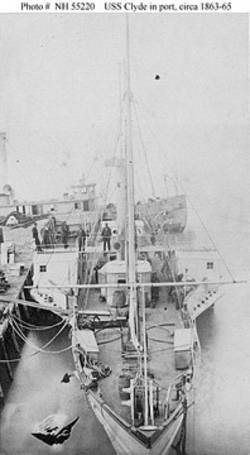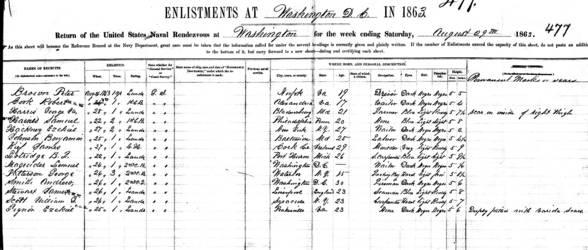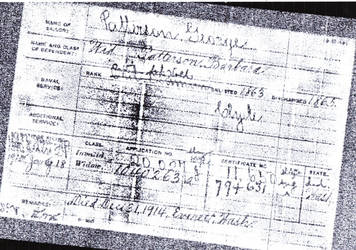George Patterson
Representing: Union
G.A.R Post
- John Buford Post #89 Everett, Snohomish Co. WA
Navy Ship
- USS Clyde
Unit History
- United States Navy
Full Unit History
U.S.S. CLYDE
Keel Laid: Inf. Not Avail.
Date Launched: Inf. Not Avail.
Commissioned: 7/29/63 U.S. Navy
Decommissioned: 8/17/65 U.S. Navy
Regimental History
VESSEL HISTORY:
The side wheel steamer that came to be known as the U.S.S. Clyde began life as the Neptune. As Neptune she was used to run the Union blockade guarding ports of The Confederate States of America. It was on 6/14/63while attempting such a run that she was captured by the U.S.S. Lackawana.
After being sent to Key West, Florida, Neptune was moved to New York, NY for survey and appraisal. There she was purchased by the U.S. Navy. She was placed in commission on 7/29/63.
Departing New York on 7/30/63 Neptune sailed to Washington, D.C. There, on 8/11 her name was changed to Clyde. Then, on 9/6/63 she sailed from Washington on 9/6/63 for duty with the East Gulf Blockading Squadron.
U.S.S. Clyde patrolled the coastal and inland waters of western Florida until the end of the war. During this period, on 9/27/63, she captured the schooner Amaranth and also participated in two expeditions up the Suwannee and Waccasassa rivers capturing nearly 200 bales of cotton.
The U.S.S. Clyde arrived at the Philadelphia Navy Yard on 8/10/65. She was decommissioned on 8/17 after which she was taken to New York City to be put on sale. She sold on 10/25/65.
A man named Henry Titus purchased Clyde and renamed her Indian River. He intended to use the steamer for shipping canned fish and oysters from the Indian River in Florida. Upon arriving at the Indian River Clyde/Indian River grounded hard in a shallow inlet and could not be refloated.
USS Clyde General Characteristics: Type = steamer; Displacement = 294 long tons (299 t.); Length = 200' 6" (61.11 m);
Beam = 18' 6" (5.64 m); Draft = 8' (2.4 m); Propulsion = steam; Speed = 9 km (10 mph; 17 km/h; Compliment (1863 – 1865) = 67; Armament = 2 x 24-pounder howitzers.
Soldier History
SAILOR:
Residence: Inf. Not Avail. Age: 15.5 yrs.
Enlisted/Enrolled: 8/26/63 Washington, D.C. Rank: 2nd Class Boy (2 C.B)
Mustered In: Inf. Not Avail.
Mustered Out: Inf. Not Avail.
Discharged: Inf. Not Avail.
Highest Rank: Able Bodied Seaman
Family History
PERSONAL/FAMILY HISTORY:
George Miles Patterson would always claim he was born 3/24/48 in Seneca Falls Seneca County, New York. However, the U.S. Census for 1850, two years or less, after his birth placed his parental family in Waterloo, Seneca County, NY. His father was James Patterson (b. 1816). His mother was Mary (nee Harduig or Harden b. 1817) Patterson. Both parents were born in England.
In 1850 James’ occupation was listed as "spinner." As the family patriarch, he would be deceased or at least absent from the Patterson household a decade later.
As far as is known George was the youngest of three children. His older siblings were: William James (b. 1843 NY) and Charles D. (b. 1846 NY) Patterson.
While nothing is known about George's childhood or formative years, documentally we do learn about him when he was quite young as he was only 15.5 years of age when, on 8/26/63 at the Washington Naval Yard, Washington, D.C. he joined the U.S. Navy. Here it should be pointed out that in the early 1860s U.S. Navy enlistments were open at a much younger age than those of the army.
At enlistment young George's vital stats were noted as follows: 5' 1/2" in height, fair of complexion, with hazel eyes and brown hair. For occupation he listed "none."
On 8/31/63, almost immediately after enlistment, George was assigned to service on a captured Confederate blockade runner renamed the U.S.S. Clyde which was just then being pressed into blockade service with the U.S. Navy. The Clyde would be his only ship of assignment throughout his military career. That being said George was present during all Clyde’s travels and wartime adventures while blockading and exploring southern waters.
Personally, George's military experience would prove to be very benign in terms of injuries or wounding as there were none noted. As for illness, military service records note only two incidents with both being the same febris remittens (remittant fever) with one bout stretching from 12/28/64 through 1/12/65 and a second from 5/5 to 7/6/65. More, later, on the long term consequences of George's naval tenure illnesses.
************************************************************************************************
Having joined the navy at such a tender age one might have thought George was looking toward a career in the U.S. Navy or at least on the water. Both proved not to be the case because with the War having ended, and he being mustered out of the service he returned to civilian life on land, never again to enter either the U.S. military or life on the water. Instead, as far as is known he returned to New York where he settled in or near the community of Waterloo. There, perhaps it could be said he met his personal "Waterloo" in terms of he living the life of a single man.........
While living post-war in Waterloo, NY George met one Barbara Morsheimer (b. 1853 NY). The two were wed on 7/3/69 in Trinity Church located in George's self- proclaimed birth town of Seneca Falls. After the wedding the two appear to have set up household in Waterloo. The union was the first and last for both and would produce two children, son George, who was born the following year (b.ca. 7/69 NY) and daughter Minnie May (b. 6/30/72 NY). Only Minnie would survive to become an adult.
Beyond getting married, July, 1869 was significant for George for another reason. At the time he was employed as a brakeman on The New York Central Railroad. Sometime in July, '69, most likely after his wedding, he became trapped between two railroad cars the result being his left thigh being lacerated and crushed to a degree that muscle tissue was torn away. He would have difficulty walking and performing anything beyond the easiest physical labor the rest of his life. On the heels of this accident George and Barbara appear to have moved in with her parents in Fayette Seneca Co., NY as that was where they - along with their one month old son, George - were residing at the time of the 1870 census. Despite his accident, in 1870 George still listed his occupation as "brakeman". More, later, on the impact of the accident.
The Patterson’s remained in New York for ten years before pulling up stakes and moving westward to Ft. Wayne, Allen County, Indiana. What prompted the move is not documented. However, George may have been following a railroad job as the Ft. Wayne census for 1880 noted his occupation as "railroad fireman." Of interest in this census is that son, George, was no longer with the family.
It was while in Indiana, ca. 1890 that George began the paper trail that he hoped would tie physical sufferings which he traced to his days of Civil War soldiering to a U.S. Government monthly disability stipend. The first available documentary evidence of this process comes from 12/20/90 when a physician in the Ft. Wayne area penned the following on George's behalf: “I did not know George Patterson before his period of military service. He claims to have been in the hospital suffering from (illeg.) and had rheumatism or neuralgia while a sailor. Later, he met with an accident that damaged his left thigh. I have treated him for rheumatism and pneumonia different times over the past two years which have confined him to bed. He is unable to withstand the effects of exposure or hard work. In my opinion he is unfit for any manual labor except for the easiest kind.” On 5/3/93 George was pensioned at $4 per month based on rheumatism and resultant rectal disease.
In 1892 the Pattersons departed Indiana and moved to Danville, IL. Again, what prompted this move is not documented.
During the year following the move to Illinois George sought a pension increase from $4 based on the above noted ailments plus heart disease. It is unclear from available documentation if this request proved successful or not.
The Patterson’s, in 1897, made an inter-Illinois move from Danville to (south) Chicago. There, his attempts to obtain a more substantial monetary pension continued with a result that in May of 1901 a physician, once again stated that in his opinion George was permanently disabled from rheumatism of his back and hips as well as disease of the bladder and kidneys. Later that same year, on 11/26, a pension-related board of physicians concluded that because of rheumatism in his left shoulder and neck, the injury to his left thigh, plus a double - complete on the left side - hernia for which he had to wear a truss and, kidney pains, the former sailor was permanently disabled and warranted a pension of $8 per month. At some pint the increase was granted, and then some as, at the time of his passing, George was receiving a $16.50 per month stipend
Sometime between 1902/'03 George and Barbara quitted Illinois and made their final westward move, this time to the Puget Sound area of western Washington State. Likely this move was made because their now-married daughter Minnie lived in Everett, WA. Their location of settlement was the Snohomish County city of Everett. Whether or not it was their first Everett address, from 1/30/11 onward 1710 Rucker Ave was home for the Patterson’s even as of the 1910 census. Continuing with the 1910 census, that tally listed George as being employed by "Channing Land." Whether this was a real estate company or a logging enterprise is not known. Also not known is George's - as a limited manual labor man - role within the company.
On 12/30/14 George Miles Patterson died suddenly. Place of death was Everett, WA. His age at passing was 66 years, 9 months and 7 days. Cause was listed on the death certificate as an apoplexy (stroke) attack suffered two days earlier. Burial was in Everett's Evergreen Cemetery.
Almost immediately after George's passing (1/11/15) Barbara Patterson had legal papers drawn up in an effort to keep receiving at least a portion of her late husband's pension. Doing the legal work was Everett attorney R.T. Warner. (Row 22 grave 1 GAR cemetery Snohomish, WA). Witnessing Barbara's signings were R.T.'s brother Edwin C. Warner (Row 22 grave 2 GAR cemetery Snohomish, WA) and R.E. Barney (burial site unk.). All three men were Civil War veterans. The application was successful. On 8/15/11 the widow Patterson was granted a pension of $12 per month retroactive to 1/15/11.
Barbara Patterson remained in the Everett Rucker Avenue home until her death on 5/12/25. Only a scant few days before her passing she received what was by then a $30 per month pension payment. Her burial was at Evergreen cemetery beside George.
After her mother's death, Minnie was aided by the local G.A.R. post in sending a letter to the pension bureau to see if any pension funds were still available to help pay for final days of care and burial. Minnie, at the time, indicated her address was 1710 Rucker, so perhaps she had been living with and caring for her mother during her final days on this earth. No response to the written inquiry is available within available paperwork.
As of November, 2017, no headstones mark the graves of either George or Barbara
*************************************************************************************************
*Although Grand Army of the Republic members assisted the widow Patterson with her pension papers after George's death and, following her death, the Everett Post #89 wrote a letter to the Pension Bureau using their post stationary, George's name has not been found on a G.A.R. membership roster.
Cemetery
Buried at Evergreen Cemetery Everett



